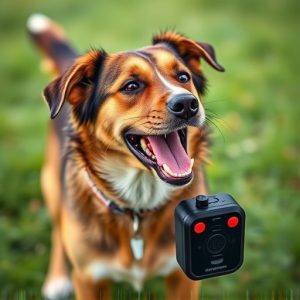Safe Power Levels: Non-Violent Dog Deterrents for Personal Protection
Understanding and managing a dog's aggression involves recognizing their "Safe Power Level…….
Understanding and managing a dog's aggression involves recognizing their "Safe Power Levels." While territorial or protective instincts are normal, techniques like firm commands, visual cues, and calm eye contact can de-escalate situations. When using deterrents like air horns, Safe Power Levels are crucial to prevent panic or harm while effectively keeping dogs at bay.
Personal protection against aggressive dogs is a crucial concern, especially for outdoor enthusiasts and those with pet dogs. This article explores effective strategies to navigate interactions with potentially dangerous canines. We delve into understanding canine aggression, from behavior patterns to triggers, offering insights for responsible dog ownership. Furthermore, we present non-violent deterrent techniques for personal safety and emphasize the importance of Safe Power Levels in using tools as dog deterrents. By combining knowledge and responsible practices, individuals can confidently navigate situations with aggressive dogs.
- Understanding Aggressive Dogs: Behavior and Triggers
- Non-Violent Deterrent Techniques for Personal Safety
- Safe Power Levels: Using Tools Responsibly for Dog Deterrence
Understanding Aggressive Dogs: Behavior and Triggers
Dogs, like humans, have unique personalities and behaviors that can vary greatly. Understanding why a dog may display aggression is crucial to ensuring safe interactions. Aggressive behavior in dogs can be triggered by a range of factors such as fear, territorial instincts, or past trauma. Some dogs exhibit high “safe power levels,” meaning they are protective of their territory or family and will assert this through aggressive means if they perceive a threat.
Recognizing these triggers is the first step in deterring potential aggression. Using positive reinforcement training methods and maintaining calm, assertive energy can help manage these behaviors. A safe power level doesn’t necessarily equate to dangerous; it simply indicates a need for careful navigation during interactions to prevent unwanted responses from the dog.
Non-Violent Deterrent Techniques for Personal Safety
When facing an aggressive dog, non-violent deterrent techniques can help ensure your safety without escalating the situation. The key is to employ strategies that maintain a safe power level, neither too confrontational nor too submissive. One effective method is using firm, assertive commands like “No” or “Stay back.” This shows determination and can deter an attack if delivered calmly but firmly.
Visual cues also play a significant role. Holding your arms up at the sides or opening your jacket to appear larger can sometimes persuade a dog to lose interest. Additionally, maintaining eye contact while remaining still or slowly backing away can communicate confidence without provoking an aggressive response. Remember, the goal is to de-escalate the situation and avoid triggering the dog’s predatory instincts through perceived weakness or panic.
Safe Power Levels: Using Tools Responsibly for Dog Deterrence
When it comes to personal protection from aggressive dogs, understanding safe power levels is crucial. Using tools designed for dog deterrence, such as air horns or high-decibel noise makers, can be effective in frightening away potential threats. However, it’s essential to wield these tools responsibly, ensuring the safety of both yourself and others around you. Misusing these devices could cause panic or even harm, so a thoughtful approach is key.
Safe power levels for dog deterrents involve considering distance, decibel level, and duration of use. For instance, an air horn should be used sparingly and from a safe distance to avoid accidental injuries. Similarly, high-pitched sounds that are too intense or prolonged can cause distress in people with sensitive hearing. By adhering to these responsible practices, individuals can effectively deter dogs without crossing into harmful territory, thereby ensuring their safety and the peace of mind they need when facing potential dog aggression.
When faced with potential aggression from a dog, understanding their behavior and employing non-violent deterrents are key to ensuring personal safety. By recognizing triggers and using tools responsibly at safe power levels, individuals can effectively navigate encounters while maintaining control. Incorporating these strategies into your approach allows for a balanced and secure interaction, promoting both your well-being and the welfare of the dog. Remember, the goal is not harm but rather a calm resolution, making you a responsible guardian in any situation.


